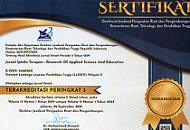Pemberian Juice Campuran Tomat dan Mentimun terhadap Penurunan Tekanan Darah kepada Penderita Hipertensi
Cici Lavenia(1*), Nurdin ,(2)
(1) Sekolah Tinggi Ilmu Kesehatan Fort De Kock, Bukittinggi
(2) Sekolah Tinggi Ilmu Kesehatan Fort De Kock, Bukittinggi
(*) Corresponding Author
Abstract
Penelitian ini bertujuan untuk melihat perbedaan sebelum dan sesudah pemberian jus campuran tomat dan mentimun terhadap penurunan tekanan darah pada penderita hipertensi diwilayah kerja Puskesmas Selayo Kapupaten Solok. Penelitian ini merupakan penelitian Quasi Eksperiment dengan desain penelitian one group pretest-postest design. Jumlah sampel pada penelitian ini sebanyak 10 orang penderita hipertensi diwilayah kerja Puskesmas Selayo Kabupaten Solok pada tahun 2014, yang diberikan jus campuran tomat dan mentimun selama 5 hari. Analisis data menggunakan uji t-test dependent untuk melihat perbedaan sebelum dan sesudah pemberian jus campuran tomat dan mentimun terhadap penurunan tekanan darah pada penderita hipertensi. Hasil penelitian bahwa pemberian jus campuran tomat dan mentimun menunjukan terdapat adanya perbedaan yang signifikan terhadap penurunan tekanan darah dengan p value = 0.000 (p ≤ 0.05) pada hari ke-3 dan p value = 0.000 (p ≤ 0.05) hari ke-5. Dari hasil penelitian dapat disimpulkan bahwa pemberian jus campuran tomat dan mentimun dapat secara efektif menurunkan tekanan darah penderita hipertensi. Perbedaan penurunan tekanan darah sudah mulai terlihat pada hari ke-3 dan hari ke-5.
Â
Kata Kunci:Â efektivitas; hipertensi; jus tomat dan mentimun; tekanan darah
This study aimed to examine the effectiveness of a mixture of tomato and cucumber juice to decrease blood pressure in hypertensive patients in Koto Baru Community Health Center Selayo Solok District 2014.    This research method is Quasi Experiment to determine the effects that arise as a result of a particular treatment. While the design of the study is one group pretest - posttest design. In this research as many as 10 samples were given a mixture of tomato and cucumber juice for 5 days,. Data were analyzed using t test dependent. To see the diference before and after guving tomato and cucumber juece to the reduction of blood pressure in patiens with hypertension. The results of the study that giving of a mixture of tomato and cucumber juice shows that there is a revealed that there is any significan difference to the decrease in blood pressure with p value = 0.000 (p ≤ 0,05) on the 3rd day and p value = 0.000 (p ≤ 0,05) on the 5th day.From the results of this research it can be concluded that the mixture of tomato and cucumber juice can be effectively lower blood pressure of hypertensive patients. The difference in blood pressure reduction was seen on the 3rd and on the 5th day.
Keywords: effectiveness; hypertension; tomato juice and cucumber; blood pressure
Â
Kata Kunci:Â efektivitas; hipertensi; jus tomat dan mentimun; tekanan darah
This study aimed to examine the effectiveness of a mixture of tomato and cucumber juice to decrease blood pressure in hypertensive patients in Koto Baru Community Health Center Selayo Solok District 2014.    This research method is Quasi Experiment to determine the effects that arise as a result of a particular treatment. While the design of the study is one group pretest - posttest design. In this research as many as 10 samples were given a mixture of tomato and cucumber juice for 5 days,. Data were analyzed using t test dependent. To see the diference before and after guving tomato and cucumber juece to the reduction of blood pressure in patiens with hypertension. The results of the study that giving of a mixture of tomato and cucumber juice shows that there is a revealed that there is any significan difference to the decrease in blood pressure with p value = 0.000 (p ≤ 0,05) on the 3rd day and p value = 0.000 (p ≤ 0,05) on the 5th day.From the results of this research it can be concluded that the mixture of tomato and cucumber juice can be effectively lower blood pressure of hypertensive patients. The difference in blood pressure reduction was seen on the 3rd and on the 5th day.
Keywords: effectiveness; hypertension; tomato juice and cucumber; blood pressure
Full Text:
Refbacks
- There are currently no refbacks.
Copyright (c) 2015 Jurnal Ipteks Terapan
Online ISSN : 2460-5611 | Print ISSN : 1979-9292
Publish by LLDIKTI Wilayah X (Sumatera Barat, Riau, Jambi dan Kepulauan Riau)
Jl. Khatib Sulaiman No 1 Kota Padang. Kode Pos 25144. Telp 0751-7056737. Fax 0751-7056737. Website:http://www.kopertis10.or.id
This work is licensed under a Creative Commons Attribution 4.0 International License.








.png)






_(1).jpg)



